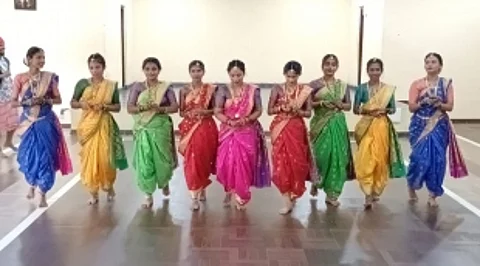

Goa not only has a rich natural beauty, it also has a vibrant cultural heritage. Unfortunately, this rich cultural heritage is getting overlooked due to the State’s “party destination” tag. Even the Goan youths are heavily influenced by the Western culture and are shunning their own traditional art forms. However, a sincere attempt is being made to turn the tide by a youth-based cultural group in Curchorem town of South Goa district, named Kala Samrajya (cultural empire).
Kala Samrajya members perform various dance forms like the Dhangar dance – performed traditionally by a shepherd community known as Dhangars. It is considered a Navratri dance, which involves a fusion of adoration, a vigorous session of worship and dance, performed to please “Bita Deva” or “Biruba” for his blessings.
The Dhangar dance, also known as Dhangari Gaja Dance, is performed in traditional Maharashtrian dresses, which include a Kathiawari-styled white dress and turban with colourful handkerchiefs. Then, there are various other dance forms like - Kunbi, Dekni, Kalshi Fugdi, Dhalo, Orulo, Goff, Musal, Talgadi, Veerbhadra, Oviyo, Aallayo and Palne Geeta.
Dekni is a semi-classical Goan dance form. One of the best known Dekni songs is ‘Hanv Saiba Poltodi Vetam’, which was adapted by thespian late Raj Kapoor as ‘Na mangoon sona chandi’ in his Hindi movie Bobby.
The story that is depicted in this song is about temple dancers who want to go for a wedding and they approach the boatman to ferry them across the river. The boatman says, “No! The river is rough!” The dancers offer the boatman their gold jewellery; but the boatman is still firm. So the dancers dance for the boatman and this time he ferries them across the river.
Vikas Bhandare, President of Kala Samrajya cultural group, says, “Initially, we started performing in another cultural group as artistes for performing folk dance. But at that time we had very little idea what folk dance was.”
“We then came to know that our ancestors, who were farmers, had developed their own folk art forms to celebrate joyous occasions like festivals or a good harvest. Then we realised how important are these dance forms for us in terms of understanding our cultural heritage and realised that it has to be preserved for our future generation,” Bhandare says.
“Today the youth is inclined more towards the Western culture, due to which our traditional art forms are on the verge of getting extinct. Having understood the real ethos of our folk music, some of us formed this group Kala Samrajya four years ago to promote traditional Goan art forms. Our main purpose is to create awareness about our culture amongst the youth of Goa through performing the various types of folk music at various public gatherings and also conduct workshops for them,” Bhandare says.
Former president and founding member of the group, Nikhil Mohandas Naik said that like-minded youngsters from various areas got together and started this group.
“We have been going to villages to spread awareness about our dance forms. We too were influenced by the Western culture. Initially, we didn’t find our folk music interesting. Then we decided to try and understand the background. Today, we perform all types of folk dances of Goa - Kunbi, Dekni, Kalshi Fugdi, Dhalo, Orulo, amongst others,” Naik says.
“We have created slots forms and practice them during free time to hone our skills and perform at various events. We are getting encouraging responses from the youngsters,” he says.
Snehal Suraj Naik, who is pursuing MA in Konkani, wherein she is studying the art and culture of Goa, says being part of this group, helps her to practice whatever she is learning in her academics.
“I love acting, dancing and writing. I like folk dance more. I have been part of this group for the last two years. I perform all the major folk dances of Goa, like Kunbi, Dekni, Kalshi Fugdi and Dhalo among others. These dances are all based on rituals. Our practice happens twice a week from 6.30 pm to 9.30 pm. I do my practice after returning from college. I balance between studies and my passion,” Snehal says.
Veenita Bhikaro Ghadi from Kakoda Curchorem, who is working as Account Assistant at a bank, says, she balances her work, family and dance proportionately.
“I finish all my work and come for practice. In case of any public performance, our practice session extends for another couple of days. Although it gets hectic sometimes, I love it since I get to showcase our culture,” she says.
Dr Samrudhi Shantaram Kautankar, a Homeopathic doctor and a Bharatanatyam dancer, says, “My association with this cultural group has allowed me to remain rooted with culture. Although I am a practicing physician, I finish my clinic work in the day and come for practice in the evening. Instead of feeling exhausted due the hectic schedule, I actually feel refreshed when I come here.”
Kala Samrajya members are working hard to keep their tradition alive. The group can certainly flourish further with support from the public at large and the State government.